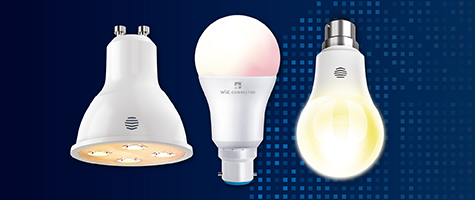Smart Lighting: A Comprehensive Guide
For centuries, we’ve illuminated our homes in the same basic way. Light a candle, blow out the candle.Turn on the light switch, turn off the light switch.
Autonomous lighting that responds to your voice, your presence, or your phone from thousands of miles away was seen as little more than science fiction.
Yet smart lighting is here - and has quickly become an extremely popular staple of any smart home setup, offering a wide range of benefits to make our homes more efficient and convenient.
If you’re completely new to smart lighting, or are simply looking for the best smart lighting products to enhance your home, this guide is for you.
Smart lighting explained
Smart lighting refers to light bulbs or light switches that connect to your Wi-Fi network, allowing you to control your lighting remotely through a smartphone or smart hub. You can do this via a touchscreen interface or by using voice commands.
Smart light bulbs allow you to fine-tune the brightness, colour, and colour temperature of your lighting. You can also set schedules for your lights to switch on/off automatically, or connect them to motion sensors that know when you’re in certain rooms, and switch lights on/off accordingly.

- Energy saving
Energy usage is a big concern for everyone at the moment. Fortunately, smart lighting can help reduce your energy bill by consuming over 5 times less energy than a standard halogen light bulb. Smart lighting also encourages more conscientious habits - such as dimming lights or turning them off when they’re not needed - increasing the potential savings even more.
- Ease of use
Smart lighting allows you to control your lights from wherever you are. Think you may have left the lights on at home whilst travelling? Simply open the app and turn them off. Snuggled up in bed and don’t want to get up? Use voice commands to easily dim or switch off the lights.
- Home safety
Scheduling features automatically turn your lights on/off whilst you’re away, making it look like someone’s home. Hive lights have a ‘mimic mode’, which turns your lights on/off in a semi-random pattern whilst you’re not home.
What types of smart lights are available?
Contrary to popular belief, smart lighting doesn't require any expensive fittings or setup equipment to work.
Much like traditional light bulbs, smart bulbs can be bought in a variety of standard light fittings, such as B22, E27, E14, GU10, etc. and can be plugged straight in.
They can also be bought in a range of stylish shapes and sizes, such as spotlight bulbs, filament bulbs, and even LED strip lights.
Click here to view our full range of smart lighting, including top smart lighting brands such as Hive, 4Lite, and Wiz.
Do smart lights work without WiFi?
Smart lights use your WiFi to connect to your phone and other smart devices - but don’t worry if your internet connection goes down.
Without an internet connection you may lose some functionality, such as being able to control your lights through your smartphone - but you won’t be left in the dark. Without a WiFi signal, most smart light bulbs work the same as a traditional light bulb and can be controlled via the light switch.

How long do smart lights last?
As we’ve discussed, smart lights are much cheaper to run than traditional lights - but this means little if you have to replace them every five minutes!
Thankfully, smart lighting uses LEDs which not only use less energy, but also last far longer than traditional halogen bulbs. The lifespan of an average smart bulb is around 23,000 hours - in other words, six hours each day for over ten years. Top models, such as the Hive Active range, can last even longer.
Energy efficient, highly customisable, and packed with clever features - there’s no doubt that homes of the future will all be lit by smart lighting systems.
Click here to view our full range of smart home products that can make your home more connected, cost-effective, and efficient.



